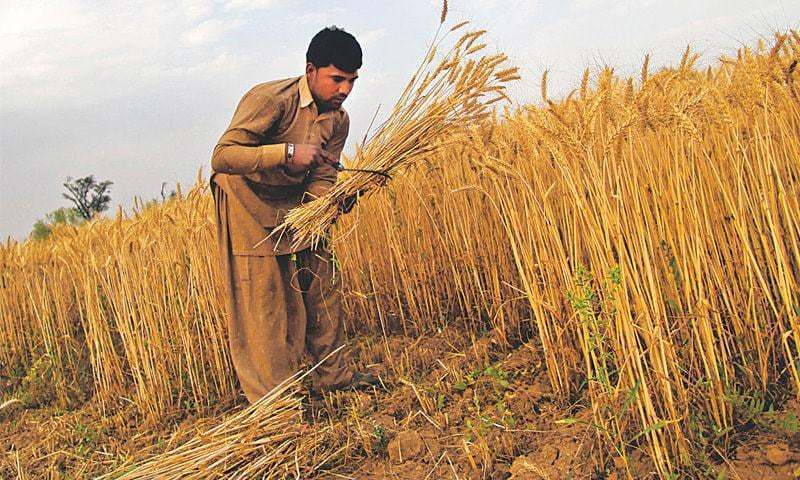The recent wheat procurement debacle in Punjab has reinforced farmers’ perceptions, already developed during the previous PML-N government’s tenure (2013-18), that the party has distanced itself from the long-standing national belief that agriculture is the backbone of Pakistan’s economy.
However, the party has yet to clearly articulate whether it envisions the manufacturing or service sector as the potential new growth engine of the economy.
Many economists still believe that industrialisation in Pakistan, like in several other countries, can lead to agricultural growth by creating a robust market for agricultural raw materials and food products, thereby propelling the country’s overall economic development.
Under this premise, the textile sector was strategically nurtured and promoted as a ‘lead sector’, albeit at the expense of farmers, who had no choice but to supply cotton at rates below international prices for several decades.
Not to delve too deeply into history, even last year, most farmers sold their cotton at Rs6,000 to Rs7,000, far below the announced support price of Rs8,500 per 40 kilograms.
All indicators highlight that the textile sector has not yet achieved, nor is it in a position to achieve, the envisioned objectives. These include the country’s sustainable and swift economic growth, a rapid increase in exports akin to Bangladesh, and the provision of wage employment to low-skilled labour on a large scale, thereby alleviating poverty.
Nonetheless, challenges such as higher energy costs, declining cotton cultivation in the country due to climate change, low sector productivity, and heightened international competition have resulted in Pakistan’s ongoing industrial slowdown.
On the contrary, several economists posit that in agrarian economies like Pakistan, which has the fifth largest population in the world, improvements in agricultural productivity and income could catalyse broader economic development.
As farmers’ income rises, they tend to invest and spend more within the country on housing, consumer goods, household appliances, vehicles, and agricultural machinery, as well as on various services, including education and health.
Such increased spending has the potential to stimulate demand for industrial and consumer products, as well as services, thereby fostering economic growth.
While the agriculture sector possesses modest export potential due to growing local demand and the heightened focus of importing countries on food safety and traceability, it holds immense potential for import substitution.
Increasing the cultivation of edible oilseeds, developing the local seed industry, and enhancing the production of ethanol — a substitute for petroleum fuel derived from sugarcane or maize — could positively impact the current account deficit.
In addition, Pakistan is grappling with the formidable challenge of a rising poverty rate and diminishing affordability and access to food for its underprivileged population.
Several reports from international development agencies highlight that growth in the agricultural sector has a greater proportional impact on poverty reduction than growth in other economic sectors.
Furthermore, the sector provides self and wage employment to less-educated and low-skilled workers — the largest segment of our ever-increasing workforce.
Moreover, Pakistan’s food security situation is highly precarious. The adverse effects of climate change on crop yields, combined with the rising twin deficits — fiscal and current account — have exacerbated the risk of an uncertain food supply in the country.
Given this context, the government may be left with no alternative but to boost the agriculture sector in a big way. Regrettably, this sector has been a victim of short-sighted and myopic policies, driven by a complex interplay between politics and economics.
Some of the adverse impacts stemming from such choices, which aim to minimise the prices of agricultural produce in the local market, are outlined here and have severely hindered the sector’s long-term growth.
In the international market, wheat hit three-year lows during the first quarter of 2024, attributed to the second-highest world production of wheat on record in 2023-2024, alongside substantial wheat exports from Ukraine and Russia.
This year, the import of cheap and substandard wheat, along with the Punjab Government’s disinterest in procuring wheat from farmers, may temporarily decrease the prices of roti (bread). Still, it comes at the expense of farmers and the growth of the agriculture sector.
Such a short-term approach may not offer a sustainable solution, given the possibility of a future rise in international prices.
Moreover, frustrated wheat farmers will resort to crop switching, leading to a decrease in wheat production next year. In such a scenario, would the government revert to its previous wheat procurement policy and forcibly collect wheat from farmers’ houses?
In a late March press conference, Foreign Minister Ishaq Dar stressed the issue of Pakistan-India trade. During the 2013-18 PML-N regime, agricultural produce, including fresh vegetables, was regularly imported from India in large quantities. While this resulted in the availability of low-priced vegetables, it came at a significant cost.
Thousands of vegetable farmers, especially tunnel farmers, had no choice but to abandon vegetable cultivation as they could not compete with India’s vegetables, which benefited from diverse agro-climatic zones and more affordable agricultural inputs.
This policy decision led to a decline in highly labour-intensive vegetable production, which employed millions. Consequently, when trade eventually ceased, the nation had to endure higher vegetable prices for subsequent years.
During 2013-17, the PML-N government artificially capped the dollar exchange rate at close to Rs100 to contain inflation and keep prices at a minimum. However, this action, while making imports cheaper, also dampened exports.
Consequently, like many other sectors, the agriculture sector struggled to establish a long-term foothold in export markets. When exports decrease, the local market becomes saturated, leading to a drop in the prices of crops.
In conclusion, should the government wish to provide agricultural produce to the public and industry at lower prices, it must pursue long-term and consistent policies to enhance crop yields by bridging the wide yield gap between Pakistan and comparable countries.
Additionally, addressing the issue of the fertiliser mafia and restructuring the prevailing agricultural marketing system, which currently eats up a large portion of farmers’ earnings, are imperative.

